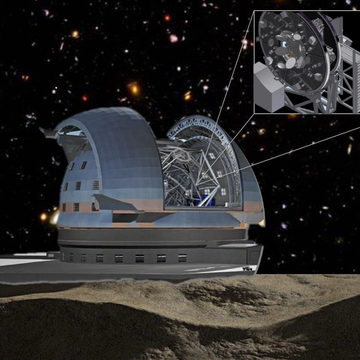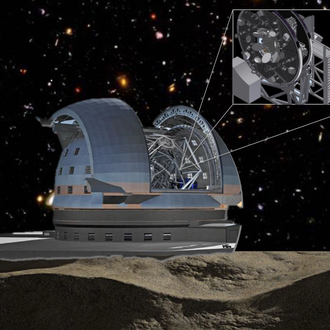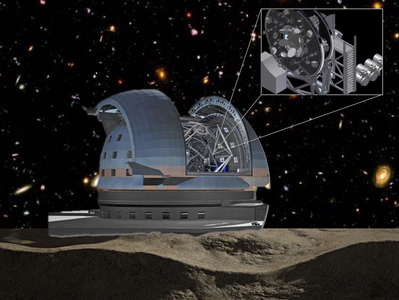MOSAIC, the Multi-Object Spectrograph of the European Extremely Large Telescope (E-ELT)

Image of the planned E-ELT. Upper right: vision of MOSAIC installed at one of the focal stations.
Credit: MOSAIC consortiumThe European Southern Observatory has signed a phase A study contract with the MOSAIC consortium. The multi-object spectrograph will be the workhorse instrument for the E-ELT, with its 39m diameter primary mirror the biggest telescope in the world. MOSAIC will be the world-leading MOS facility, contributing to all fields of contemporary astronomy, from extra-solar planets, to the study of the halo of the Milky Way and its satellites, and from resolved stellar populations in nearby galaxies out to observations of the earliest ‘first-light’ structures in the Universe.
The ESO contract has been signed by the CNRS-INSU (Leading Institute of the MOSAIC Consortium) on March 18, 2016, during the MOSAIC kick-off meeting at the Paris Observatory in the presence of the team(*) led by François Hammer. The Consortium includes five Leading Countries (France, UK, The Netherlands, Brazil and Germany, and six Associated Partners (Austria, Finland, Italy, Portugal, Spain, and Sweden).
The MOSAIC instrument will combine high multiplex and high spatial resolution to resolve important questions in astronomy and cosmology. It will investigate when the first galaxies are formed and how they aggregate into large galaxies such as the Milky Way. It will study the distribution of the dark and ordinary matter at all scales and age of the Universe. It will reveal important new insight into the physics of galaxies beyond the Local Group, study the Galactic Center and observe the evolution and formation of extra-solar planets.
The local team leader at the Leibniz Institute for Astrophysics Potsdam, Martin Roth, states: "MOSAIC is the next contribution of AIP to a major instrumentation project of the European Southern Observatory (ESO) in Chile. It builds on the experience of AIP astrophysicists gathered in ESO projects MUSE and 4MOST. And the strategy of the innovation center innoFSPEC Potsdam has payed off yet another time. With partners such as the University of Göttingen or the Fraunhofer Institute IOF in Jena we are looking forward to strengthen our lead position in the area of fibre-based spectroscopy over the decade to come."
Publication: "MOSAIC: a Multi-Object Spectrograph for the E-ELT", Andreas Kelz, Francois Hammer, Pascal Jagourel, and the MOSAIC consortium. http://arxiv.org/abs/1512.00777
Update Nov. 2017: A nice video introducing MOSAIC is now available here: https://www.youtube.com/watch?v=LabjWnsQvuo
Science contact:
Prof. Dr. Martin M Roth, mmroth@aip.de, +49 331-7499 313
Dr. Andreas Kelz, akelz@aip.de, +49 331-7499 640
Media contact: Dr. Janine Fohlmeister, presse@aip.de, +49 331-7499 802
(*) The team includes Pascal Jagourel (Observatoire de Paris), Chris Evans (UK-ATC, Edinburgh), Mathieu Puech (Observatoire de Paris), Gavin Dalton (RAL & Oxford Univ.), Myriam Rodrigues (Observatoire de Paris), Ewan Fitzsimons (UK-ATC, Edinburgh), Simon Morris (Durham Univ.), Beatriz Barbuy (IAG, Sao Paulo), Jean-Gabriel Cuby (LAM, Marseille), Lex Kaper (Amsterdam Univ.), Martin Roth (AIP, Potsdam), Gerard Rousset (Observatoire de Paris), Richard Myers (Durham Univ.), Olivier Le Fèvre (LAM, Marseille), Alexis Finogenov (Helsinki Univ.), Bruno Castilho (LAN, Itajuba), Göran Östlin (Stockholm Univ.), Jesus Gallego (Madrid, Computense Univ.), Fabrizio Fiore (Roma Observatory), Bodo Ziegler (Vienna Univ.), Jose Afonso (Lisboa Univ.), Marc Dubbledam (Durham Univ.), Phil Parr Burman (UK-ATC), Tim Morris (Durham Univ.), Tristan Buey (Observatoire de Paris), Fanny Chemla (Observatoire de Paris), Eric Gendron (Observatoire de Paris), Andreas Kelz (AIP, Potsdam), Isabelle Guinouard (Observatoire de Paris), Ian Lewis (Oxford Univ.), Kevin Middleton (RALSPACE, Oxford), Ramon Navarro (NOVA), Marie Larrieu (IRAP, Toulouse), Thierry Contini (IRAP, Toulouse), Kjetil Dohlen (LAM, Marseille), Harald Nicklas (Univ. Göttingen), David Le Mignant (LAM, Marseille), Yanbin Yang (Observatoire de Paris).

Image of the planned E-ELT. Upper right: vision of MOSAIC installed at one of the focal stations.
Credit: MOSAIC consortiumThe European Southern Observatory has signed a phase A study contract with the MOSAIC consortium. The multi-object spectrograph will be the workhorse instrument for the E-ELT, with its 39m diameter primary mirror the biggest telescope in the world. MOSAIC will be the world-leading MOS facility, contributing to all fields of contemporary astronomy, from extra-solar planets, to the study of the halo of the Milky Way and its satellites, and from resolved stellar populations in nearby galaxies out to observations of the earliest ‘first-light’ structures in the Universe.
The ESO contract has been signed by the CNRS-INSU (Leading Institute of the MOSAIC Consortium) on March 18, 2016, during the MOSAIC kick-off meeting at the Paris Observatory in the presence of the team(*) led by François Hammer. The Consortium includes five Leading Countries (France, UK, The Netherlands, Brazil and Germany, and six Associated Partners (Austria, Finland, Italy, Portugal, Spain, and Sweden).
The MOSAIC instrument will combine high multiplex and high spatial resolution to resolve important questions in astronomy and cosmology. It will investigate when the first galaxies are formed and how they aggregate into large galaxies such as the Milky Way. It will study the distribution of the dark and ordinary matter at all scales and age of the Universe. It will reveal important new insight into the physics of galaxies beyond the Local Group, study the Galactic Center and observe the evolution and formation of extra-solar planets.
The local team leader at the Leibniz Institute for Astrophysics Potsdam, Martin Roth, states: "MOSAIC is the next contribution of AIP to a major instrumentation project of the European Southern Observatory (ESO) in Chile. It builds on the experience of AIP astrophysicists gathered in ESO projects MUSE and 4MOST. And the strategy of the innovation center innoFSPEC Potsdam has payed off yet another time. With partners such as the University of Göttingen or the Fraunhofer Institute IOF in Jena we are looking forward to strengthen our lead position in the area of fibre-based spectroscopy over the decade to come."
Publication: "MOSAIC: a Multi-Object Spectrograph for the E-ELT", Andreas Kelz, Francois Hammer, Pascal Jagourel, and the MOSAIC consortium. http://arxiv.org/abs/1512.00777
Update Nov. 2017: A nice video introducing MOSAIC is now available here: https://www.youtube.com/watch?v=LabjWnsQvuo
Science contact:
Prof. Dr. Martin M Roth, mmroth@aip.de, +49 331-7499 313
Dr. Andreas Kelz, akelz@aip.de, +49 331-7499 640
Media contact: Dr. Janine Fohlmeister, presse@aip.de, +49 331-7499 802
(*) The team includes Pascal Jagourel (Observatoire de Paris), Chris Evans (UK-ATC, Edinburgh), Mathieu Puech (Observatoire de Paris), Gavin Dalton (RAL & Oxford Univ.), Myriam Rodrigues (Observatoire de Paris), Ewan Fitzsimons (UK-ATC, Edinburgh), Simon Morris (Durham Univ.), Beatriz Barbuy (IAG, Sao Paulo), Jean-Gabriel Cuby (LAM, Marseille), Lex Kaper (Amsterdam Univ.), Martin Roth (AIP, Potsdam), Gerard Rousset (Observatoire de Paris), Richard Myers (Durham Univ.), Olivier Le Fèvre (LAM, Marseille), Alexis Finogenov (Helsinki Univ.), Bruno Castilho (LAN, Itajuba), Göran Östlin (Stockholm Univ.), Jesus Gallego (Madrid, Computense Univ.), Fabrizio Fiore (Roma Observatory), Bodo Ziegler (Vienna Univ.), Jose Afonso (Lisboa Univ.), Marc Dubbledam (Durham Univ.), Phil Parr Burman (UK-ATC), Tim Morris (Durham Univ.), Tristan Buey (Observatoire de Paris), Fanny Chemla (Observatoire de Paris), Eric Gendron (Observatoire de Paris), Andreas Kelz (AIP, Potsdam), Isabelle Guinouard (Observatoire de Paris), Ian Lewis (Oxford Univ.), Kevin Middleton (RALSPACE, Oxford), Ramon Navarro (NOVA), Marie Larrieu (IRAP, Toulouse), Thierry Contini (IRAP, Toulouse), Kjetil Dohlen (LAM, Marseille), Harald Nicklas (Univ. Göttingen), David Le Mignant (LAM, Marseille), Yanbin Yang (Observatoire de Paris).
Images
Image of the planned E-ELT. Upper right: vision of MOSAIC installed at one of the focal stations.
Big screen size [1000 x 750, 810 KB]
Original size [1173 x 880, 1000 KB]



